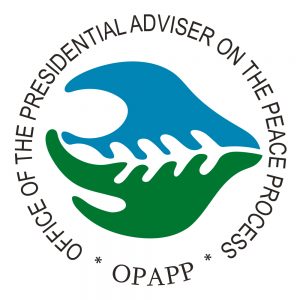 By OPPAP
By OPPAP
Towards the full transformation of the KAPATIRAN
The historic signing of the Clarificatory Implementing Document (CID) between the Philippine government and the Rebolusyonaryong Partidong Manggagawa ng Pilipinas/ Revolutionary Proletarian Army/ Alex Boncayao Brigade- Tabara Paduano Group (RPM-P/RPA/ABB-TPG), or KAPATIRAN on July 19, 2019 brought the former revolutionary group a step closer in transforming itself into a mainstream socio-economic and political organization.
The CID is an annex to the 2000 peace agreement between the revolutionary group and the Philippine government. It outlines the commitment made by both parties, which could lead to the signing of an exit agreement.
On September 19, 2019, 727 KAPATIRAN members were decommissioned in Jamindan, Capiz, which was witnessed by no less than President Duterte.
Around 266 KAPATIRAN members also completed their Community Defense Unit (CDU) training with the Armed Forces of the Philippines on November 5, 2019, and soon after were deployed to communities.
Aside from receiving immediate cash assistance worth PhP 25,000 each, the decommissioned members were also provided with livelihood projects, skills training seminars, housing projects, and employment opportunities.
Implementing the Sipat in the Cordillera
The Sipat Agreement signed in 1986 with the Cordillera Bodong Administration – Cordillera People’s Liberation Army (CBA-CPLA) put an end to the conflict between the government and former rebel group.
The signing of a Memorandum of Agreement in 2011 further strengthened the peace agreement, which follows a five-year Normalization Plan.
Since the forging of the agreement, the CPLA has been on a journey towards transforming its members into peaceful and productive members of society, and developing the full socio-economic potential of their communities.
On October 23, 2020, 444 firearms owned by CPLA members were inventoried while 353 were turned over to the Police Regional Office – Cordillera and were destroyed at Camp Bado Dangwa in La Trinidad, Benguet.
In terms of socio-economic opportunities, 508 CPLA members and their next-of-kin were employed as forest guards by the Department of Environment and Natural Resources; 932 members and their next of kin were enrolled in the PAyapa at MAsaganang PamayaNAn (PAMANA)-PhilHealth Sponsored Program in 2019; and 72 grantees of the PAMANA-Commission on Higher Education (CHED) Study Grant Program have graduated, while 38 student-recipients continue to receive assistance under the program.
To serve as a joint mechanism between the government and the CBA-CPLA in resolving issues and concerns, the two parties created the Joint Evaluation and Monitoring Committee (JEMC) composed of CBA-CPLA leaders, and representatives from the Armed Forces of the Philippines, Philippine National Police, OPAPP, CAR regional line agencies, and civil society organizations.
Shaping our future
Acknowledging that there is a need to address the root causes of armed conflict, OPAPP also created the Social Healing and Peacebuilding (SHAPE) Program that seeks to rebuild the torn social fabric brought by the cycle of armed violence.
Under the SHAPE Program, the National Action Plan on Women, Peace and Security (NAPWPS) is being implemented to ensure that women have an increased role in the decision-making and peacebuilding process.
Aside from empowering women, the SHAPE Program also provides a platform for the youth to actively contribute to the formulation of the National Action Plan on Youth, Peace and Security.
Moreover, the program also gives indigenous peoples and internally displaced persons (IDPs) an opportunity to be agents of peace and development.
All of these interventions are geared towards achieving the government’s goal of building a peaceful and brighter future for the next generation.
The PAMANA for the Filipino people
Meanwhile, the Payapa at Masaganang Pamayanan (PAMANA) Program serves as a testament that in the pursuit of just and lasting peace, strategic socio-economic projects must be carried out in communities affected by armed conflict.
The PAMANA program is anchored on the government’s strategy of winning the peace by forging strategic partnerships in promoting a convergent delivery of goods and services, and addressing regional development challenges in conflict-affected and conflict-vulnerable areas.
It builds both physical and social infrastructure at the regional, provincial and barangay levels to ensure that communities are not left behind in the development process.
The design and delivery of the PAMANA Program is conflict-sensitive and peace-promoting (CSPP), distinguishing it from other development interventions of the government.
Since 2017, the PAMANA Program has allocated almost PHP 18 billion to implement 4,000 projects across the country.
These projects include, among others, the PHP 60 million Bangayan-Zapanta Valley Road project in San Agusan del Norte; the third phase of the PHP 70 million Tagbongabong-Kaularan-San Antonio Farm-to-Market road in San Agusan del Norte; the rehabilitation of the Level III water system level III in Magpet, North Cotabato benefitting 575 households; and post-harvest equipment contributing to the sustainable livelihood and development of farmers in 12 municipalities in Sultan Kudarat.
“Mga kababayan, ang lahat ng mga peace milestones na aking nabanggit ay resulta ng sinseridad at determinasyon ng Administrasyong Duterte na isulong ang komprehensibong prosesong pangkapayapaan sa bansa,” Galvez said.
“Ito ang simbolo ng tapang at malasakit ng pamahalaan para sa lahat ng mga Pilipino, at ito po ang legasiya at pamana na nais iwanan ni Pangulong Duterte sa ating mga mahal na kababayan,” he concluded.
